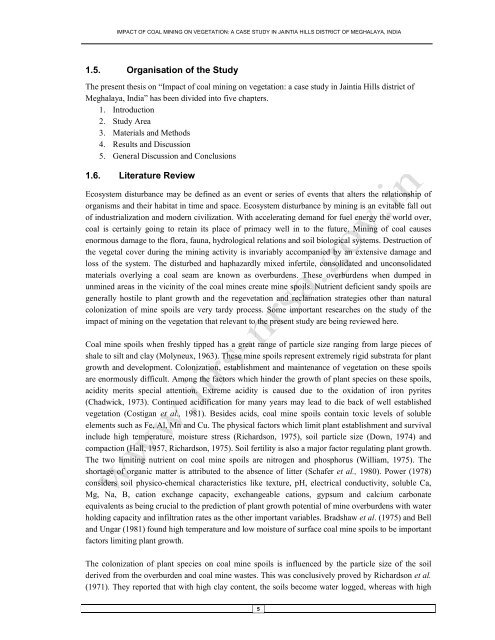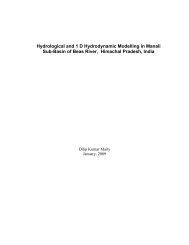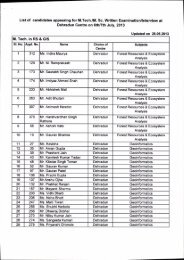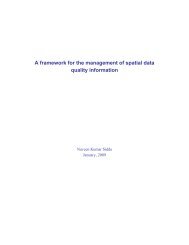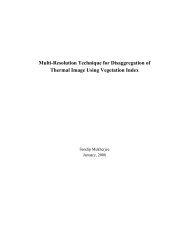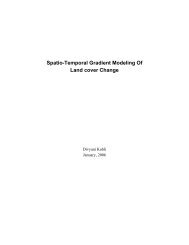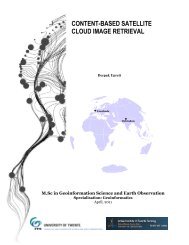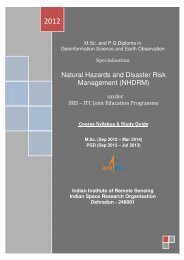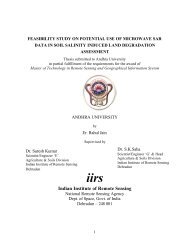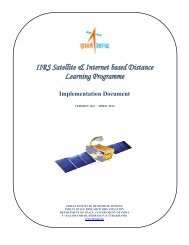Impact of Coal Mining on Vegetation: A Case Study in Jaintia Hills ...
Impact of Coal Mining on Vegetation: A Case Study in Jaintia Hills ...
Impact of Coal Mining on Vegetation: A Case Study in Jaintia Hills ...
You also want an ePaper? Increase the reach of your titles
YUMPU automatically turns print PDFs into web optimized ePapers that Google loves.
IMPACT OF COAL MINING ON VEGETATION: A CASE STUDY IN JAINTIA HILLS DISTRICT OF MEGHALAYA, INDIA1.5. Organisati<strong>on</strong> <str<strong>on</strong>g>of</str<strong>on</strong>g> the <strong>Study</strong>The present thesis <strong>on</strong> “<str<strong>on</strong>g>Impact</str<strong>on</strong>g> <str<strong>on</strong>g>of</str<strong>on</strong>g> coal m<strong>in</strong><strong>in</strong>g <strong>on</strong> vegetati<strong>on</strong>: a case study <strong>in</strong> Ja<strong>in</strong>tia <strong>Hills</strong> district <str<strong>on</strong>g>of</str<strong>on</strong>g>Meghalaya, India” has been divided <strong>in</strong>to five chapters.1. Introducti<strong>on</strong>2. <strong>Study</strong> Area3. Materials and Methods4. Results and Discussi<strong>on</strong>5. General Discussi<strong>on</strong> and C<strong>on</strong>clusi<strong>on</strong>s1.6. Literature ReviewEcosystem disturbance may be def<strong>in</strong>ed as an event or series <str<strong>on</strong>g>of</str<strong>on</strong>g> events that alters the relati<strong>on</strong>ship <str<strong>on</strong>g>of</str<strong>on</strong>g>organisms and their habitat <strong>in</strong> time and space. Ecosystem disturbance by m<strong>in</strong><strong>in</strong>g is an evitable fall out<str<strong>on</strong>g>of</str<strong>on</strong>g> <strong>in</strong>dustrializati<strong>on</strong> and modern civilizati<strong>on</strong>. With accelerat<strong>in</strong>g demand for fuel energy the world over,coal is certa<strong>in</strong>ly go<strong>in</strong>g to reta<strong>in</strong> its place <str<strong>on</strong>g>of</str<strong>on</strong>g> primacy well <strong>in</strong> to the future. <str<strong>on</strong>g>M<strong>in</strong><strong>in</strong>g</str<strong>on</strong>g> <str<strong>on</strong>g>of</str<strong>on</strong>g> coal causesenormous damage to the flora, fauna, hydrological relati<strong>on</strong>s and soil biological systems. Destructi<strong>on</strong> <str<strong>on</strong>g>of</str<strong>on</strong>g>the vegetal cover dur<strong>in</strong>g the m<strong>in</strong><strong>in</strong>g activity is <strong>in</strong>variably accompanied by an extensive damage andloss <str<strong>on</strong>g>of</str<strong>on</strong>g> the system. The disturbed and haphazardly mixed <strong>in</strong>fertile, c<strong>on</strong>solidated and unc<strong>on</strong>solidatedmaterials overly<strong>in</strong>g a coal seam are known as overburdens. These overburdens when dumped <strong>in</strong>unm<strong>in</strong>ed areas <strong>in</strong> the vic<strong>in</strong>ity <str<strong>on</strong>g>of</str<strong>on</strong>g> the coal m<strong>in</strong>es create m<strong>in</strong>e spoils. Nutrient deficient sandy spoils aregenerally hostile to plant growth and the regevetati<strong>on</strong> and reclamati<strong>on</strong> strategies other than naturalcol<strong>on</strong>izati<strong>on</strong> <str<strong>on</strong>g>of</str<strong>on</strong>g> m<strong>in</strong>e spoils are very tardy process. Some important researches <strong>on</strong> the study <str<strong>on</strong>g>of</str<strong>on</strong>g> theimpact <str<strong>on</strong>g>of</str<strong>on</strong>g> m<strong>in</strong><strong>in</strong>g <strong>on</strong> the vegetati<strong>on</strong> that relevant to the present study are be<strong>in</strong>g reviewed here.<str<strong>on</strong>g>Coal</str<strong>on</strong>g> m<strong>in</strong>e spoils when freshly tipped has a great range <str<strong>on</strong>g>of</str<strong>on</strong>g> particle size rang<strong>in</strong>g from large pieces <str<strong>on</strong>g>of</str<strong>on</strong>g>shale to silt and clay (Molyneux, 1963). These m<strong>in</strong>e spoils represent extremely rigid substrata for plantgrowth and development. Col<strong>on</strong>izati<strong>on</strong>, establishment and ma<strong>in</strong>tenance <str<strong>on</strong>g>of</str<strong>on</strong>g> vegetati<strong>on</strong> <strong>on</strong> these spoilsare enormously difficult. Am<strong>on</strong>g the factors which h<strong>in</strong>der the growth <str<strong>on</strong>g>of</str<strong>on</strong>g> plant species <strong>on</strong> these spoils,acidity merits special attenti<strong>on</strong>. Extreme acidity is caused due to the oxidati<strong>on</strong> <str<strong>on</strong>g>of</str<strong>on</strong>g> ir<strong>on</strong> pyrites(Chadwick, 1973). C<strong>on</strong>t<strong>in</strong>ued acidificati<strong>on</strong> for many years may lead to die back <str<strong>on</strong>g>of</str<strong>on</strong>g> well establishedvegetati<strong>on</strong> (Costigan et al., 1981). Besides acids, coal m<strong>in</strong>e spoils c<strong>on</strong>ta<strong>in</strong> toxic levels <str<strong>on</strong>g>of</str<strong>on</strong>g> solubleelements such as Fe, Al, Mn and Cu. The physical factors which limit plant establishment and survival<strong>in</strong>clude high temperature, moisture stress (Richards<strong>on</strong>, 1975), soil particle size (Down, 1974) andcompacti<strong>on</strong> (Hall, 1957, Richards<strong>on</strong>, 1975). Soil fertility is also a major factor regulat<strong>in</strong>g plant growth.The two limit<strong>in</strong>g nutrient <strong>on</strong> coal m<strong>in</strong>e spoils are nitrogen and phosphorus (William, 1975). Theshortage <str<strong>on</strong>g>of</str<strong>on</strong>g> organic matter is attributed to the absence <str<strong>on</strong>g>of</str<strong>on</strong>g> litter (Schafer et al., 1980). Power (1978)c<strong>on</strong>siders soil physico-chemical characteristics like texture, pH, electrical c<strong>on</strong>ductivity, soluble Ca,Mg, Na, B, cati<strong>on</strong> exchange capacity, exchangeable cati<strong>on</strong>s, gypsum and calcium carb<strong>on</strong>ateequivalents as be<strong>in</strong>g crucial to the predicti<strong>on</strong> <str<strong>on</strong>g>of</str<strong>on</strong>g> plant growth potential <str<strong>on</strong>g>of</str<strong>on</strong>g> m<strong>in</strong>e overburdens with waterhold<strong>in</strong>g capacity and <strong>in</strong>filtrati<strong>on</strong> rates as the other important variables. Bradshaw et al. (1975) and Belland Ungar (1981) found high temperature and low moisture <str<strong>on</strong>g>of</str<strong>on</strong>g> surface coal m<strong>in</strong>e spoils to be importantfactors limit<strong>in</strong>g plant growth.The col<strong>on</strong>izati<strong>on</strong> <str<strong>on</strong>g>of</str<strong>on</strong>g> plant species <strong>on</strong> coal m<strong>in</strong>e spoils is <strong>in</strong>fluenced by the particle size <str<strong>on</strong>g>of</str<strong>on</strong>g> the soilderived from the overburden and coal m<strong>in</strong>e wastes. This was c<strong>on</strong>clusively proved by Richards<strong>on</strong> et al.(1971). They reported that with high clay c<strong>on</strong>tent, the soils become water logged, whereas with high5


